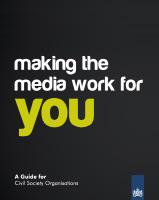Too often, developing communications strategies for civil society organizations is ignored. The belief, I think, is that if the mission is there, then people will support it, and it will take root. Many think there’s no need for a methodology in engaging communities in what we do.
But the problem is that we, the mission-driven, often live in a bubble of our own creating. As someone who handles a communications strategy for a small nonprofit organization, I feel it every day. We often fall into the trap of thinking people are intuitively aware of who we are and what we do.
Except that most people are busy living their lives, not living my organization’s mission. And so my role becomes: develop a strategy that informs people about my very niche topic. And for organizations starting from scratch—either those entrenched in bureaucracies that fail to see the value in engagement, or those in newer organizations working with limited resources—getting a coherent and effective message out can be a major obstacle.
 The European Journalism Centre (who released an incredible verification handbook last year) developed a primer for civil society organizations and nonprofits looking to increase their visibility, at a time when the online space has created a “jungle of competing demands for the public’s attention.” Highlighting specific communications strategies that have worked in the past, and running through hypothetical scenarios for brand directors, the EJC’s new handbook gets to the point rather quickly: Making the Media Work for You. The handbook is a compilation of lessons learned by the Press Freedom 2.0 Consortium over the last four years in its training of communications officers at local NGOs in Bolivia, Georgia, Kenya, and South Africa.
The European Journalism Centre (who released an incredible verification handbook last year) developed a primer for civil society organizations and nonprofits looking to increase their visibility, at a time when the online space has created a “jungle of competing demands for the public’s attention.” Highlighting specific communications strategies that have worked in the past, and running through hypothetical scenarios for brand directors, the EJC’s new handbook gets to the point rather quickly: Making the Media Work for You. The handbook is a compilation of lessons learned by the Press Freedom 2.0 Consortium over the last four years in its training of communications officers at local NGOs in Bolivia, Georgia, Kenya, and South Africa.
Though the reality for many is that “heart of an organization’s media output” is the press release, and press conferences are still a norm, ignoring the world of digital media and how it has transformed the way we access information would render most efforts of CSOs useless.
Thus, EJC’s inclusion of digital (and particularly social) media. Today, more and more organizations are able to bypass traditional methods of informing the public, and instead post their content themselves.
There are important takeaways for all actors and skill levels, both for nonprofits and emerging journalism organizations new to the digital strategy game. The handbook deals with macro concepts like accuracy and accountability in messaging, then more micro points like maintaining clear goals for communications strategies, and the minutiae of what to post (if content is king, then visual content is the throne).
To see this work painted for the every-man was refreshing—and hopefully it will help bring some much-needed validity to what communications practitioners do.

Comments (0)